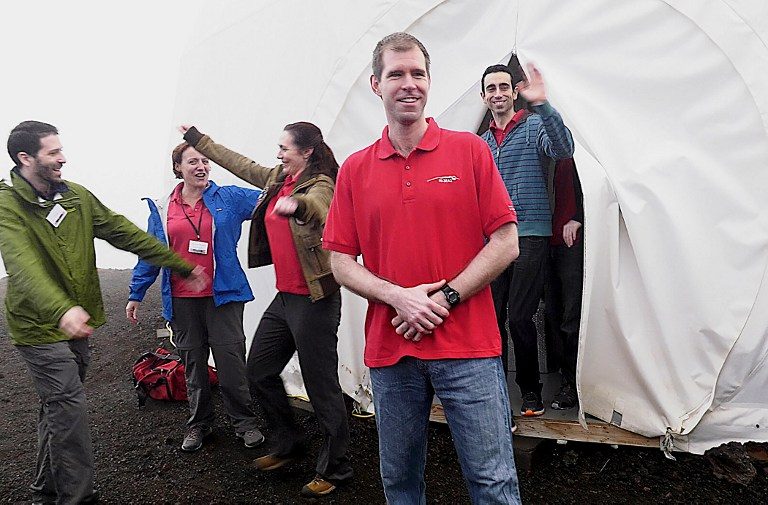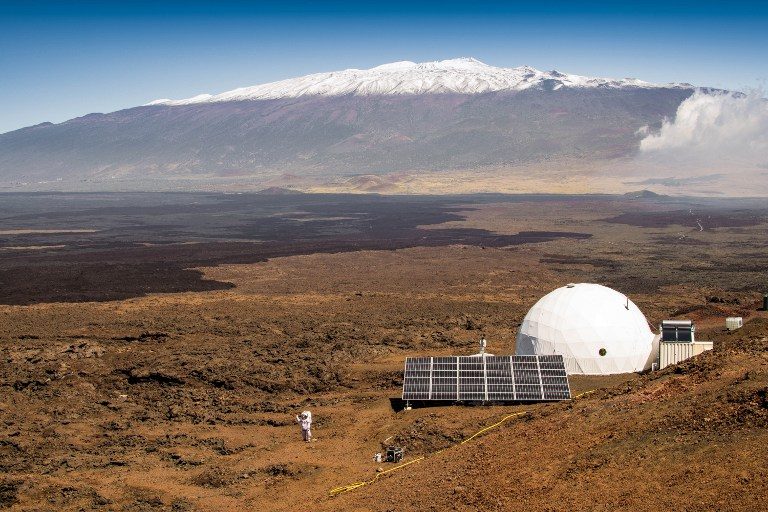SUMMARY
This is AI generated summarization, which may have errors. For context, always refer to the full article.

LOS ANGELES, USA – Monotony was the hardest part of a yearlong NASA experiment about the mental and psychological rigors of longterm spaceflight, crew members said after the test ended.
The 6-member crew emerged Sunday, August 28, from a dome in Hawaii, on the barren northern slope of the Mauna Loa volcano, where they were studied as part of the US space agency’s mission to send people to Mars by the 2030s.
On Monday, August 29, US President Barack Obama congratulated them, writing on Twitter: “Congrats to NASA and the scientists taking us a step closer to Mars. Now enjoy Hawaii and get a shave ice!”
Congrats to NASA and the scientists taking us a step closer to Mars. Now enjoy Hawaii and get a shave ice! https://t.co/lFZjSnn38x
— President Obama (@POTUS) August 29, 2016
In addition to insufficient stimulation, isolation and a lack of fresh food and air were the toughest challenges during the yearlong experiment, known as the Hawaii Space Exploration Analog and Simulation (HI-SEAS) – the third and longest of its kind.
The team locked themselves into the dome, located in an abandoned quarry far from animals and vegetation, on August 28, 2015.
“We were always in the same place, always with the same people,” said French astrobiologist Cyprien Verseux in a Periscope interview by organizers posted on Twitter.
The crew lived inside a structure 36 feet (11 meters) in diameter and 20 feet tall, emerging only if outfitted in spacesuits, never breathing the outside air or eating fresh produce.
Despite describing the monotony as the hardest part, Verseux said the experiment shows that “a mission to Mars in the close future is realistic.”
He said a key hurdle involves producing food and a small-scale ecosystem on Mars, where the atmosphere is thin, the ground dry and water is scarce.
The experiment did not test the process of growing food, but was aimed primarily at the psychological study of the crew.
“The technical and psychological problems can be overcome,” Verseux said.
‘Bring books’
Video footage of the team as they emerged shows the 3 men and 3 women looking a bit bewildered as they met visitors and well-wishers and posed for selfies. Organizers gave them fresh fruit and vegetables.
In interviews, the crew was upbeat but made passing references to arguments and growing tired of seeing the same faces.
Verseux’s advice to new volunteers on a similar isolation experiment: “Bring books.”
Another mission member, American Tristan Bassingthwaighte, agreed, urging future participants to bring “lots of books.”
Bassingthwaighte said that team members engaged in hobbies such as salsa dancing and playing the ukelele to stave off the boredom.
“If you can work on something that is self-developmental… you will not go crazy,” he said.
Powdered cheese, canned tuna

The men and women had their own small rooms, with space for a sleeping cot and desk, and spent their days eating food like powdered cheese and canned tuna.
The dome had composting toilets and showers, and was powered by solar energy. Team members had limited Internet access.
Team members could venture outside only in spacesuits, and Bassingthwaighte said that the “astronauts” removed a vast amount of garbage from the flanks of the volcano in their excursions.
Christiane Heinicke from Germany said that her main experiment was extracting water from the ground – adding that the volcanic soil on Mauna Loa is very similar in mineral composition to the Martian soil.
“You can actually get water from a ground that is seemingly dry,” she said.
“The implication is that you could get water from Mars.”
She said that having “something meaningful to work on” was key to helping her endure the year-long mission.
However, she also spoke of the difficulties of living in close quarters with the same group of people for a long time, and said she planned to stay in close contact with only 3 of the other 5.
The crew also included a pilot, a doctor/journalist and a soil scientist.
The full analysis of the team’s psychological performance has yet to be revealed, but it is expected to be published in the coming months.
“We are just starting the debrief week,” lead researcher Kim Binsted told Agence France-Presse by phone from Hawaii.
“They didn’t break the simulation, they did all the things we asked of them, and all of those things are pretty good signs,” she said.
“It certainly wasn’t worse than expected. Every crew has conflicts.”
Next crew
NASA is studying how these long-term isolation scenarios play out on Earth before pressing on toward Mars, which the US space agency hopes to reach sometime in the 2030s.
NASA can currently send a robot to the Red Planet in about eight months, but astronauts traveling to Mars face a trip lasting between one and three years.
The first HI-SEAS experiment involved studies about cooking on Mars and was followed by a 4-month and an 8-month cohabitation mission.
Two more HI-SEAS missions are planned starting in January 2017 and 2018. Both are scheduled to last 8 months, and organizers are already looking for volunteers. – Rappler.com
Add a comment
How does this make you feel?
There are no comments yet. Add your comment to start the conversation.